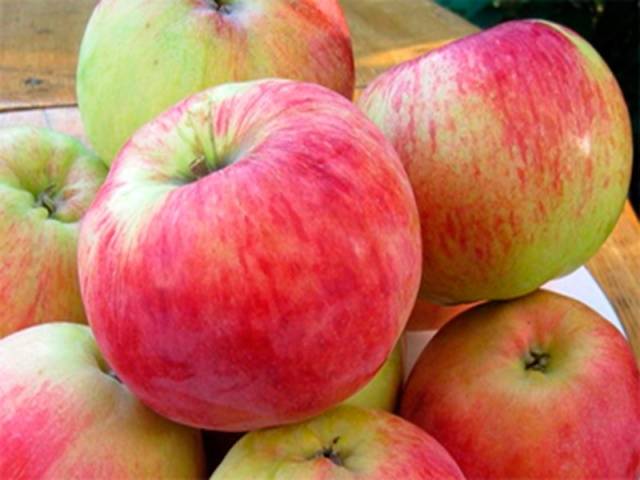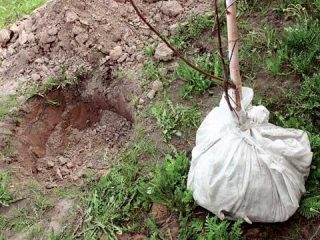Content
To form a real garden, it is advisable to plant several varieties of apple trees. Orlovim apple trees have many advantages and are completely undemanding to care for. Therefore, even a novice gardener will be able to grow a good harvest.
Description of the variety
Orlovim trees very quickly reach their final height (about 4.5-5 m). The round or broom-shaped crown is medium dense. The main branches grow sparsely and most often have a curved shape. Often they extend from the trunk almost perpendicularly. The bark and main branches are colored light brown. The surface of the trunk often peels off. The oblong leaves have a greenish color with a slight yellowish tint.
The fruits are slightly oblique in shape and have an average size and weight of approximately 125-165 g. The glossy smooth skin of ripe apples is colored with stripes of rich red color.
The pulp of Orlovim fruits has a creamy tint. The structure of the fruit is characterized by dense juiciness. According to reviews from summer residents, apples have a strong aroma and a pleasant sour-sweet taste.
The root system of the Orlovim apple tree extends in depth (approximately 4.5 m) and in breadth, so it takes up quite a lot of space.
The Orlovim variety is characterized by high frost resistance.Also, the apple tree is not often affected by scab.
There are several advantages of the Orlovim variety:
- fruiting begins quite early;
- volumetric harvest;
- if you normalize the size of the harvest, you can regulate the size of the fruit;
- elegant appearance and excellent taste of apples.
Among the disadvantages, it is worth paying attention to the short shelf life of Orlovim apples, the significant height of mature trees (harvesting is difficult), and the loss of immunity to scab with age.
Planting seedlings
When choosing a place for a seedling of the Orlovim variety, special attention should be paid to the level of illumination of the area. It is this indicator that affects the yield and taste of Orlovim fruits.
Since this variety does not tolerate highly moist soils, seedlings are planted on hills or a good drainage layer is provided. The optimal soil option for the Orlovim variety is chernozem, loamy or sandy loam soil.
Soil preparation
To ensure that the seedling takes root easily, the planting hole is prepared in advance. Suitable pit parameters: diameter 0.6-0.8 m, depth - 0.5-0.6 m. Moreover, it is advisable to stack the fertile and lower layers of soil separately.
A small layer of drainage is laid at the bottom of the hole (especially important if the groundwater is shallow). First fill up the top fertile layer of soil. The remaining soil is thoroughly mixed with humus, compost, ash and mineral fertilizer are added.
Planting stages:
- The root of the Orlovim variety seedling is carefully examined. Sections should be white. If there is a brown tint, it means the root has been damaged and needs to be shortened a little using pruners or a knife.
- First, drive a stake into the center of the hole - this will be a support for the seedling. Then the tree is lowered into the hole and the roots are carefully straightened.
- The hole is filled with a fertile mixture. The soil around the Orlovim variety seedling is compacted.
- A small depression in the form of a ditch is made around the circumference of the pit. Thanks to this, moisture will be absorbed in the right place.
- The surface of the ground around the seedling is watered and mulched with sawdust or peat.
Watering trees
The irrigation regime depends on the type of soil and climatic characteristics of the region. On average, for one watering you need:
- for an annual seedling – 2-3 buckets;
- two-year-old Orlovim apple tree - 4-5 buckets of water;
- for adult apple trees - approximately 60 liters per square meter of trunk circle. The soil should be saturated with water to about 60-80 cm.
It is important not only to pour out the required amount of water, but also to do it on time. The first time the soil is moistened is when the Orlovim apple tree has finished blooming. The next watering is carried out when the trees already have ovaries.
The trees are watered for the third time after the harvest, before the autumn frosts. Thanks to watering, the Orlovim apple tree will better withstand frost.
Watering the apple tree is carried out around the circumference of the crown. To do this, dig a groove 10-15 cm deep, and you need to dig carefully so as not to damage the root system. Water is poured in portions. After watering, the soil must be loosened.
Fertilizer application
During the season, Orlovim apple trees are fertilized three to four times. To carry out fertilizing, two methods are used: with the root method, fertilizers are applied to the soil, and with the foliar method, the crown of the apple tree is sprayed.
The first fertilization is carried out in April.To do this, you can spread about four buckets of humus on the ground, as it contains the nitrogen that trees need to grow. If there is no manure, then urea will be an excellent replacement. The fertilizer is diluted with water, and a weak solution is made for seedlings and young Orlovim apple trees.
The second fertilizing is applied during the flowering of this variety of apple trees. An excellent composition for this period: 400 g of potassium sulfate, 500 g of superphosphate and 5 liters of manure liquid are diluted in 100 liters of water. This mixture should sit for about a week. Then the trunk ditches of the Orlovim apple tree are well saturated with water, and then with a solution. With this method of fertilizing, the fertilizer goes directly to the roots.
After the formation of ovaries on the Orlovim apple tree, a third feeding is carried out. Prepare the following mixture: 500 g of nitrophoska, 10 g of sodium humate are also diluted in 100 liters of water. For one adult tree, 3 buckets of mineral solution are enough. In order for the fertilizer to be better absorbed, you need to lightly dig up the soil after watering (but shallowly so as not to damage the roots). Then it is advisable to lay a layer of mulch around the trunk of the apple tree.
Apple tree pruning
This procedure is needed, first of all, to ensure access of air and light inside the crown of the Orlovim variety and to rejuvenate the tree.
The most suitable time for pruning an Orlovim apple tree is spring and autumn:
- in the spring, before the buds appear, frozen branches are removed and a crown is formed;
- In autumn, pruning is carried out when all the foliage has fallen. Old, diseased or broken branches are removed.
The branches growing inside the crown or parallel are always cut out. Moreover, from two branches, the old or diseased one is selected for pruning.
Harvesting
Young apple trees begin to bear fruit already in 3-4 years and are characterized by stable yields.From a ten-year-old Orlovim apple tree you can harvest about 60-80 kg of fruit, and an older tree produces about 100 kg of apples.
Typically, for the middle zone, the apple harvesting period occurs at the end of August and lasts until the end of September. In the process of collecting ripe apples, Orlovim must be careful: avoid strong impacts of the fruits or their falling. Since the apples simply split apart.
Tree diseases
The Orlovim apple tree variety is resistant to scab, but sometimes the tree can become infected with powdery mildew, which is a fungal disease. Most often, the disease affects foliage. Symptoms appear in the form of a dense whitish coating located on the leaves, shoots, and fruits of the Orlovim apple tree (as in the photo).
If the disease is not dealt with, you can lose 40-60% of the harvest. In addition, the frost resistance of the tree is significantly reduced. In a densely planted garden, this disease spreads very quickly.
The most effective method of combating the disease is regular spraying of the crown with Orlovim with special preparations or colloidal sulfur, a solution of potassium permanganate. As a preventive measure, it is recommended to treat the crown with Bordeaux mixture.
The hardy Orlovim variety has taken root well in the gardens of Russia, Belarus and Ukraine due to high annual yields and immunity to scab.














